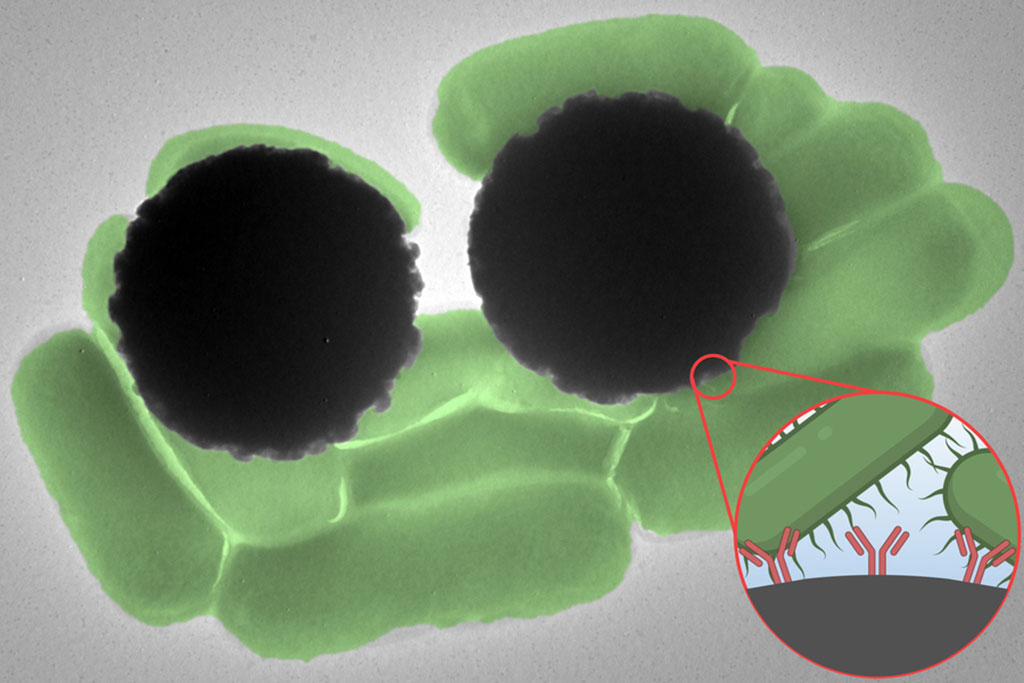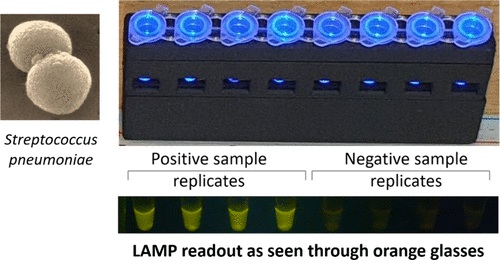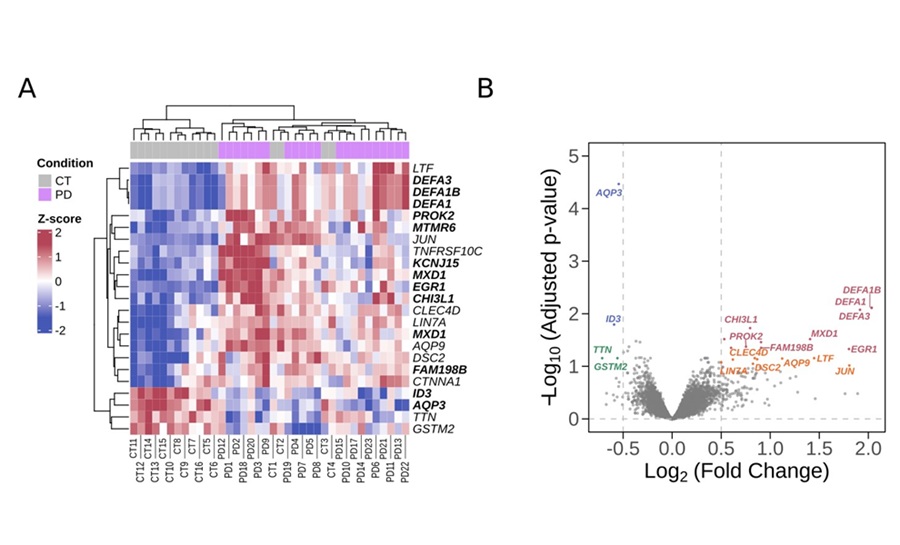Portable Device to Quickly Detect Bacterial Pathogens Using New Optical Signature
|
By LabMedica International staff writers Posted on 28 Aug 2023 |

Receiving results from a blood test or other diagnostic assessments often involves a waiting period of one to seven days, depending on the specific test's target. This time lag can be primarily attributed to the laborious steps in sample processing and analysis. The quantities of diseased cells or pathogens in fluid samples are so minute that they require cultivation in controlled settings to increase their numbers. Subsequently, these cultures are stained and examined under a microscope. This comprehensive procedure extends over several days to yield a conclusive positive or negative outcome. Now, researchers have identified a new optical signature in a commonly used class of magnetic beads, known as Dynabeads. This discovery holds the potential to speed up the detection of contaminants in various diagnostic tests, such as identifying traces of the foodborne pathogen Salmonella.
Dynabeads, microscopic magnetic beads, are capable of being coated with antibodies that attach to specific target molecules, like pathogens. Typically, Dynabeads are integrated into solutions to capture desired molecules, but further time-consuming steps are essential to confirm their presence and attachment to the beads. A team of scientists at Massachusetts Institute of Technology (MIT, Cambridge, MA, USA) have leveraged optics, specifically Raman spectroscopy, to confirm the presence of Dynabead-bound pathogens. Raman spectroscopy is an optical technique for identifying specific molecules through the unique way in which a molecule scatters light, referred to as their "Raman signature." The researchers discovered that Dynabeads exhibit an unusually strong Raman signature, similar to a fluorescent tag, enabling rapid detection with this distinctive signature functioning as a "reporter." Detecting this signal quickly can confirm the existence of a target pathogen in a given sample within less than a second.
In a practical demonstration, the researchers mixed Dynabeads into vials containing Salmonella-contaminated water. These beads were magnetically isolated onto microscope slides, after which the researchers measured how light scattered through the fluid upon exposure to laser light. Within just half a second, the Dynabeads' Raman signature was detected, confirming the presence of bound Dynabeads and, consequently, Salmonella in the fluid. This novel technique surpasses conventional methods in speed and incorporates components that could be adapted into more compact, portable formats. The team is actively working on devising a portable device capable of rapidly detecting an array of bacterial pathogens. In particular, the researchers aim to apply this approach to critical conditions such as sepsis, where prompt pathogen detection is vital and existing lab tests may not rapidly fulfill this requirement.
“This technique would be useful in a situation where a doctor is trying to narrow down the source of an infection in order to better inform antibiotic prescription, as well as for the detection of known pathogens in food and water,” said study co-author Marissa McDonald, a graduate student in the Harvard-MIT Program in Health Sciences and Technology. “Additionally, we hope this approach will eventually lead to expanded access to advanced diagnostics in resource-limited environments.”
“There are a lot of cases, like in sepsis, where pathogenic cells cannot always be grown on a plate,” said Jongwan Lee, MIT Postdoctoral Associate and study co-author. “In that case, our technique could rapidly detect these pathogens.”
Related Links:
MIT
Latest Technology News
- Cell-Sorting Device Uses Electromagnetic Levitation to Precisely Direct Cell Movement

- Embedded GPU Platform Enables Rapid Blood Profiling for POC Diagnostics
- Viral Biosensor Test Simultaneously Detects Hepatitis and HIV
- Acoustofluidic Device to Transform Point-Of-Care sEV-Based Diagnostics
- AI Algorithm Assesses Progressive Decline in Kidney Function
- Taste-Based Influenza Test Could Replace Nasal Swabs with Chewing Gum
- 3D Micro-Printed Sensors to Advance On-Chip Biosensing for Early Disease Detection
- Hybrid Pipette Combines Manual Control with Fast Electronic Aliquoting
- Coral-Inspired Capsule Samples Hidden Bacteria from Small Intestine
- Rapid Diagnostic Technology Utilizes Breath Samples to Detect Lower Respiratory Tract Infections
Channels
Clinical Chemistry
view channel
VOCs Show Promise for Early Multi-Cancer Detection
Early cancer detection is critical to improving survival rates, but most current screening methods focus on individual cancer types and often involve invasive procedures. This makes it difficult to identify... Read more
Portable Raman Spectroscopy Offers Cost-Effective Kidney Disease Diagnosis at POC
Kidney disease is typically diagnosed through blood or urine tests, often when patients present with symptoms such as blood in urine, shortness of breath, or weight loss. While these tests are common,... Read moreMolecular Diagnostics
view channel
New Diagnostic Method Detects Pneumonia at POC in Low-Resource Settings
Pneumonia continues to be one of the leading causes of death in low- and middle-income countries, where limited access to advanced laboratory infrastructure hampers early and accurate diagnosis.... Read more
Blood Immune Cell Analysis Detects Parkinson’s Before Symptoms Appear
Early diagnosis of Parkinson’s disease remains one of the greatest challenges in neurology. The condition, which affects nearly 12 million people globally, is typically identified only after significant... Read moreHematology
view channel
ADLM’s New Coagulation Testing Guidance to Improve Care for Patients on Blood Thinners
Direct oral anticoagulants (DOACs) are one of the most common types of blood thinners. Patients take them to prevent a host of complications that could arise from blood clotting, including stroke, deep... Read more
Viscoelastic Testing Could Improve Treatment of Maternal Hemorrhage
Postpartum hemorrhage, severe bleeding after childbirth, remains one of the leading causes of maternal mortality worldwide, yet many of these deaths are preventable. Standard care can be hindered by delays... Read more
Pioneering Model Measures Radiation Exposure in Blood for Precise Cancer Treatments
Scientists have long focused on protecting organs near tumors during radiotherapy, but blood — a vital, circulating tissue — has largely been excluded from dose calculations. Each blood cell passing through... Read moreImmunology
view channel
Blood-Based Liquid Biopsy Model Analyzes Immunotherapy Effectiveness
Immunotherapy has revolutionized cancer care by harnessing the immune system to fight tumors, yet predicting who will benefit remains a major challenge. Many patients undergo costly and taxing treatment... Read more
Signature Genes Predict T-Cell Expansion in Cancer Immunotherapy
Modern cancer immunotherapies rely on the ability of CD8⁺ T cells to rapidly multiply within tumors, generating the immune force needed to eliminate cancer cells. However, the biological triggers behind... Read morePathology
view channel
New Molecular Analysis Tool to Improve Disease Diagnosis
Accurately distinguishing between similar biomolecules such as proteins is vital for biomedical research and diagnostics, yet existing analytical tools often fail to detect subtle structural or compositional... Read more
Tears Offer Noninvasive Alternative for Diagnosing Neurodegenerative Diseases
Diagnosing and monitoring eye and neurodegenerative diseases often requires invasive procedures to access ocular fluids. Ocular fluids like aqueous humor and vitreous humor contain valuable molecular information... Read moreTechnology
view channel
Cell-Sorting Device Uses Electromagnetic Levitation to Precisely Direct Cell Movement
Sorting different cell types—such as cancerous versus healthy or live versus dead cells—is a critical task in biology and medicine. However, conventional methods often require labeling, chemical exposure,... Read more
Embedded GPU Platform Enables Rapid Blood Profiling for POC Diagnostics
Blood tests remain a cornerstone of medical diagnostics, but traditional imaging and analysis methods can be slow, costly, and reliant on dyes or contrast agents. Now, scientists have developed a real-time,... Read moreIndustry
view channel
Qiagen Acquires Single-Cell Omics Firm Parse Biosciences
QIAGEN (Venlo, Netherlands) has entered into a definitive agreement to fully acquire Parse Biosciences (Seattle, WA, USA), a provider of scalable, instrument-free solutions for single-cell research.... Read more
Puritan Medical Products Showcasing Innovation at AMP2025 in Boston
Puritan Medical Products (Guilford, ME, USA), the world’s most trusted manufacturer of swabs and specimen collection devices, is set to exhibit at AMP2025 in Boston, Massachusetts, from November 11–15.... Read more
Advanced Instruments Merged Under Nova Biomedical Name
Advanced Instruments (Norwood, MA, USA) and Nova Biomedical (Waltham, MA, USA) are now officially doing business under a single, unified brand. This transformation is expected to deliver greater value... Read more






















